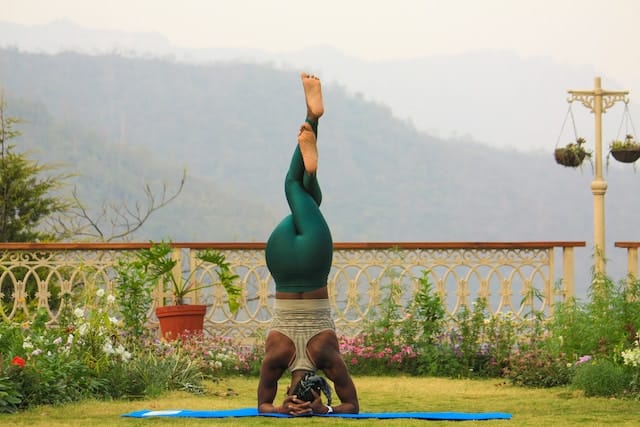Why Yoga Is A Powerful Tool In Holistic Wellness
Yoga is a powerful tool for holistic health because it’s a practice that unites the mind, body, and spirit. This blog will show you how to include yoga in your holistic wellness practice.
This article may contain links from our partners. We may receive a small commission if you make a purchase through a link. Please read my privacy policy to learn more about affiliate links and how I keep this blog sustainable.
Yoga is one of the most powerful tools you can use in a holistic wellness practice. Holistic health is about prioritizing wellness in all areas of life, not just in the physical body. And yoga embraces that philosophy because it, itself, is a holistic healthcare system.
Beyond body movement, yoga influences the mind, spirit, emotions, environment, and social connections. It’s a practice that creates a well-rounded approach to well-being.
At its core, yoga means union — it’s the union of the mind, body, and spirit. It uses a combination of poses, meditation, and breathwork to stimulate overall wellness.
As an avid yoga fan, I’ve been a practitioner for many years. The positive changes yoga has influenced in my life are clear. From helping me build a strong body to teaching me how to calm my mind to supporting me in my connection with my higher self, yoga has been one of the best modalities for manifesting my best life.
In this article, we’ll explore the profound impact of yoga on the journey to holistic well-being and delve into the many ways it can transform our lives.

Table of Contents:
What Is Holistic Wellness?
The Benefits of Creating a Holistic Yoga Practice
How to Practice Yoga for Holistic Wellness
Essential Tools for a Holistic Yoga Practice
Frequently Asked Questions About Yoga in Holistic Wellness
Final Thoughts on Yoga in Holistic Wellness
What Is Holistic Wellness?
When most people think about health, they usually only consider physical health, like the effectiveness of the immune system or the strength of a muscle. Holistic wellness is the idea that optimal health is more than the absence of a virus or illness. It’s an approach to wellness that includes all aspects of living.
These aspects of life include:
- Mental
- Bodily
- Spiritual
- Emotional
- Environmental
- Social
Understanding your body and mind on a holistic level helps you approach your health practices in a more complete manner.
Why It’s Important To Have a Holistic Approach to Health
Imbalance in one area of life can create imbalance in other areas. For instance, consider your diet. Even if you eat healthy and exercise daily, if you’re stressed out of your mind, the stress can influence your health in a negative way. Stress alone can cause health problems like digestive issues, headaches, muscle aches, and heart disease.
Meanwhile, maintaining healthy mental and spiritual practices can contribute to overall health by reducing stress, improving focus and cognition, and increasing motivation to live a healthier lifestyle.
Yoga is an excellent tool for holistic wellness because yoga incorporates three out of the six major aspects of holistic health: mind, body, and spirit.
How Can Yoga Help Improve Holistic Health?
Yoga is holistic by definition. The term “Yoga” comes from the Sanskrit word “Yuj,” which means “to unite.” Specifically, yoga means to unite the physical and mental body with spiritual consciousness and the universe. In other words, the practice is the intention to unite humans with the natural world.
It’s the intention of unity that makes yoga different from other popular health practices. It’s also why yoga is such an amazing tool to help improve holistic health.
Not only is yoga a form of exercise that provides many health benefits for your body but yoga also incorporates breathwork and meditations that are great for your mind and soul. Integrating a yoga practice into your routine not only supports consistent exercise but also adds a sense of harmony, balance, and positive thinking to your lifestyle.
That’s why yoga is so fantastic for holistic living.

The Benefits of Creating a Holistic Yoga Practice
Since yoga is the unity of mind, body, and spirit, incorporating yoga into your daily or weekly routine will have profound benefits in all three of these areas. Yoga can also positively affect our emotional, social, and environmental health since all areas of life are interconnected.
Let’s get into some specifics on how yoga can influence the mind-body connection.
The Body: Benefits of Yoga for Physical Health
You probably know yoga best by the different positions — known as asanas — like downward dog or tree pose. During yoga practice, you hold these positions for extended periods of time while focusing on your breath and searching for a sense of calmness to find relaxation in the stretch.
While these asanas are often slow-moving, they contain many health benefits for the body.
Some of these benefits include:
- Increased Flexibility: Yoga’s gentle stretches can lengthen your ligaments and tendons, expanding your range of motion.
- More Stability and Balance: Many asanas aim to help improve your balance. In addition to increasing stability, balance poses like the tree pose or danser’s pose strengthen muscles and support better posture.
- Healthier Organs: Many poses, like twists and cat-cow, double as gentle massages for your organs. Not only will these poses feel super juicy, but they also improve blood circulation. This can lead to benefits like detoxification, increased energy, and better digestive health.
- Healthier Lungs: Breathwork in yoga enhances respiratory muscle strength. This results in improved lung capacity and better oxygenation.
While this list is far from the complete benefits yoga provides for the body, it shows how much this type of exercise can contribute to a holistic wellness routine.

The Mind: Benefits of Yoga for Mental Health
Nowadays, stress is part of everyday life. Nearly every person has struggled with symptoms of stress, overwhelm, or burnout. The fact that stress is normal is actually extremely dangerous. If you live with it long enough, stress can create some pretty scary consequences, like physical, mental, and emotional issues. (There’s that mind-body connection again.)
Luckily, practicing yoga for holistic wellness can help lower your stress levels.
One of the ways yoga helps with stress is with breathwork. Breathwork is incredibly beneficial because it calms the parasympathetic nervous system. Practicing breathwork sends a signal to the brain that you’re safe. That way the brain can stop sending out the stress hormones triggering the fight, flight, freeze, or fawn reactions.
In yoga, this breathwork practice is called pranayama.
In addition to relieving stress, yoga contains many more benefits for mental health, including:
- Increased memory
- Better sleep patterns
- Decreased depression
- Overall better moods
Some other cool things yoga can help with include increasing the hippocampus, building neural connections, and releasing healthy hormones for happier moods. All of which leads to better brain health.

Spirit: Benefits of Yoga for Spiritual Health
Spirituality is a major part of what makes us human. While the definition of spirituality will mean something different to everyone, yoga is likely to make you feel more connected to your spiritual self. This is another reason why having a yoga practice is perfect for overall holistic wellness.
Here are a few ways yoga can benefit your spiritual health:
- Mindfulness and Presence: Yoga can help you develop a deeper connection to your inner self and foster spiritual awareness.
- Inner Peace and Calm: Meditation and deep breathing can help you find inner peace and calm. This sense of tranquility can create the space for spiritual exploration and introspection.
- Connection to Higher Self: Yoga encourages self-discovery, which can lead to a deeper understanding of your spiritual nature.
- Compassion and Empathy: Many yogic philosophies emphasize compassion, both for oneself and others.
- Enhanced Self-Awareness: Self-exploration might lead you to question your values, beliefs, and purpose. This can facilitate spiritual growth and alignment with your core values.
Incorporating yoga into your life can be a transformative journey that not only enhances physical and mental well-being but also deepens your spiritual connection and understanding of yourself and the world around you.

How to Practice Yoga for Holistic Wellness
When you picture a yoga practice, what images come to mind? You’re probably picturing someone bending themselves into a human pretzel. Or maybe you see someone balancing on their head or hands like a ninja or acrobat.
Luckily, you don’t have to learn complicated yoga poses if you don’t want to. There are many types of yoga practices, so there’s a style that will work for every body.
Gentle Yoga for Holistic Wellness
Yoga doesn’t have to mean learning to twist your body like a contortionist or hold difficult positions until you think your muscles are about to snap. Gentle yoga is a style of practice where you can softly improve your flexibility and range of motion without wondering if your next step should be to join the circus.
Gentle yoga styles facilitate increased strength and stamina. They enhance posture and alignment and induce a profound sense of relaxation. The practice of gentle yoga can also serve as a potent stress-reduction tool. It elevates the quality of your sleep and strengthens your immune system.
Consistent engagement with gentle yoga paves the way for an enriched holistic wellness journey.

Moderate Yoga Styles for Holistic Wellness
If you’re in search of a moderate yoga style, you may like one of the following:
- Vinyasa Yoga: Vinyasa yoga is an active style that harmonizes movement with breath. This practice can elevate cardiovascular endurance and cultivate a strong core.
- Hatha Yoga: Hatha yoga is a gentle practice that emphasizes breath control and extended pose-holding. This can lead to improved flexibility, balance, and physical strength.
- Iyengar Yoga: Iyengar yoga is ideal if you’re focused on refining your posture and attaining proper form in every yoga pose. This style of yoga uses blocks and other props to make sure each asana is correct.
Exploring these options can provide you with a well-rounded introduction to the world of yoga and its holistic health benefits.
Vigorous Yoga Styles for Holistic Wellness:
Ashtanga and Bikram are fantastic for enhancing cardiovascular health and revving up the metabolism. They also have a remarkable detoxifying effect on the body.
Ashtanga yoga contains a structured sequence of poses. Meanwhile, Bikram yoga is also known as hot yoga because the practice takes place in a hot room. Both styles encourage sweating, which causes impurities to release through the skin.
If you’re seeking a dynamic and challenging yoga experience that revitalizes the body and mind, try exploring Ashtanga and Bikram yoga.
Use Yoga Nidra for Rest
While it’s tempting to want to only take part in vigorous forms of yoga, rest is an essential component of holistic wellness. Yoga Nidra, often referred to as “yogic sleep,” is an exceptional way to incorporate relaxation and meditation into your yoga practice. After all, its primary goal is to attain complete physical, mental, and emotional serenity.
Through breathwork, Yoga Nidra calms your body to a state of absolute relaxation. But even as you’re deeply relaxed, your mind remains alert and conscious. It’s an excellent practice for reducing stress and tension. It also contributes to improved sleep and benefits the immune system.
Mentally, Yoga Nidra offers respite from anxiety and depression. It enhances focus and concentration and ignites the flames of creativity.

Bringing Holistic Yoga Into Your Nutrition
Yoga is more than an exercise practice. It’s a way of life. This means you can incorporate yoga into other aspects of your lifestyle, like nutrition.
Yoga is about the mind-body-soul connection. And what better way to holistically approach this connection than through the wonderful world of food!
Here are a few ways you can bring yoga mindfulness to the dinner table:
- Cultivate mindful eating habits: Devote your full attention to your meals. Connect with the sensations and flavors. This practice fosters awareness of how different foods affect your body.
- Eat when hungry: Respond to genuine hunger cues rather than adhering to rigid meal schedules or eating out of boredom.
- Focus on whole foods: These natural choices tend to be richer in nutrients. While avoiding processed foods entirely isn’t always possible, try eating whole foods when you can.
- Love your veggies: These vibrant foods supply your body with vital nutrients your body needs.
- Water, water, and more water: Proper hydration is key to maintaining overall health and vitality. They say you should drink about half an ounce to an ounce of water for every pound you weigh.
Embracing a yoga mindset while eating will empower you to make mindful, nourishing choices that promote your well-being and vitality.
Essential Tools for a Holistic Yoga Practice
When choosing to incorporate a yoga practice into your routine leaves you with the option of practicing at home or at a studio. Most yoga studios have everything you could desire when it comes to yoga tools. But if you decide to practice your routine at home primarily, then you might want to collect some of the essential yoga equipment to support you in your wellness journey.
Here are the essential tools I recommend for a holistic yoga practice:
- Yoga Mat — This is a non-negotiable. While you could opt for a folded blanket instead, a yoga mat is an essential tool to keep your practice safe and comfortable. Opt for an eco-friendly option to support sustainable practices.
- Yoga Blocks — These blocks are also essential, especially if you’re a yoga newbie. They’ll help you safely practice poses until you gain more flexibility. But even seasoned pros benefit from the help of yoga blocks sometimes.
- Comfy Clothes — Whether it’s yoga pants like these or some other flexible material, you want to wear something comfortable when stepping on the mat.
- Yoga Socks — While not technically essential, yoga socks will help anyone who needs a little extra grip when balancing the mat.
These yoga essentials will help you curate a practice that supports your holistic health and well-being.

Frequently Asked Questions About Yoga in Holistic Wellness
Now that we’ve covered how yoga can be a great benefit in holistic wellness let’s go over a few frequently asked questions to give you a full and complete picture of how to incorporate this practice into your daily life.
Is Yoga a Form of Holistic Medicine?
In addition to being a great form of exercise, yoga is also a form of holistic medicine. Within the foundation of yoga, the mind and the body work together to achieve overall health. Yoga can be used as a therapy to address physical or mental ailments. It’s a wonderful practice to use to relieve health concerns like anxiety, depression, insomnia, high blood pressure, and blood circulation, and provide relief for cancer, diabetes, or Parkinson’s disease.
Yoga is a holistic approach because it addresses many aspects of life, including physical, mental, spiritual, and emotional well-being.
How Yoga Can Be a Part of Integrative Medicine
Integrative medicine is a medical practice that creates customized treatments for patients by combining Western medicine with holistic medicine. Because integrative medicine incorporates holistic practices, yoga can absolutely be a part of integrative medicine.
The many health benefits that yoga provides can be a beneficial addition to many treatment plans for various illnesses.
What Is the Science of Yoga?
Yoga is unique in that it is a science, art, and philosophy. Any type of exercise is a science because it’s the study of movement and the way the body reacts to these movements.
The science of yoga combines two distinct forms of muscle engagement. Isotonic activity is where muscles contract and shorten under load. And isometric activity is when you hold a position under load, as seen in prolonged asanas. This unique combination not only enhances flexibility but also contributes to muscle strength development.
What Is the Importance of Yoga in Holistic Wellness?
Yoga is one of the few truly holistic practices because it touches on nearly every aspect of life. Yoga contributes to stress management, strong mental health, mindfulness, strength training, quality sleep, healthy aging, healthy eating, brain health, and so much more.
Because yoga can positively influence so much, it is an essential practice to include in your overall holistic wellness plan.

Final Thoughts on Yoga in Holistic Wellness
Holistic wellness is a multifaceted approach that recognizes the interconnectedness of physical, mental, emotional, spiritual, environmental, and social aspects of our lives. Yoga, with its roots embedded in unity, is an invaluable tool on the path to holistic well-being.
Yoga not only strengthens the body but also fosters mindfulness and spiritual awareness. It provides a bridge to deeper self-connection and understanding. Yoga enables us to address the imbalances in our lives and find harmony within and with the world around us.
Whether you choose gentle, moderate, or vigorous yoga styles, or even the restorative practice of Yoga Nidra, yoga offers a holistic approach that can profoundly impact your physical, mental, and spiritual health.
By incorporating yoga into your life, you embark on a transformative path that not only enhances your overall well-being but also deepens your connection to yourself and the world. So, step onto the mat, breathe, and unite your mind, body, and spirit in the pursuit of holistic wellness. Namaste.

Did you enjoy this yoga guide? Check out some of our other blogs for mindset and personal development:
Additional Resources:
Mindset Guides:
The Complete Guide to Limiting Beliefs and How To Conquer Them
Meditation for Beginners: 9 Steps on How to Clear Your Mind
How to Lower Your Anxiety Now: 5 Easy Hacks You Can Use in the Moment
Books to Grow Your Mindset:
These are books that transformed my life and led me to where I am today, and I am confident they’ll do the same for you.
Think and Grow Rich by Napoleon Hill
Outwitting the Devil by Napoleon Hill
The Big Leap: Conquer Your Hidden Fear and Take Life to the Next Level
The Complete Wallace D. Wattles Collection
Click Here to see more from the Adventuring Dreamers Resources.



